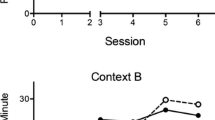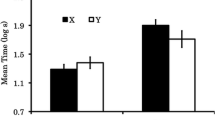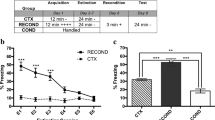Abstract
We have shown previously that the antiepileptic phenytoin impairs transfer in an instrumental learning task (Banks et al., 1999). The present study examined the effects of contextual alterations on appetitive-to-aversive transfer performance of rats treated with either phenytoin or tang. Adult rats were tested in tone-signaled appetitive and aversive instrumental tasks, where the animal bar-pressed to obtain a food reward (sugar pellet) or to avoid shock. Rats were trained on the appetitive task for 31 days. Beginning on the twenty-first day, rats were gavaged with either phenytoin or tang twice daily. Animals were then transferred to aversive training, with the phenytoin or tang treatment continuing throughout the 25 testing days. For some animals, contextual changes were introduced as they shifted from appetitive to aversive training, while for other animals these changes were not made. Phenytoin-treated rats that were presented with changes in context as they transferred from the appetitive to the aversive task learned the avoidance response to levels substantially higher than drug-treated rats not presented with the contextual changes. These results indicate that phenytoin impairs avoidance learning following transfer from the appetitive task, and that this impairment can be eliminated by introducing changes in context at the point of transfer. In the tang-treated control subjects, on the other hand, there was no improvement in transfer learning performance associated with the changes in contextual cues. This pattern of results suggests that contextual encoding processes in rats being trained in an instrumental appetitive-to-aversive paradigm are dramatically affected by phenytoin.
Similar content being viewed by others
References
Anagnostaras, S.G., Gale, G.D., & Fanselow, M.S. (2001). Hippocampus and contextual fear conditioning: recent controversies and advances.Hippocampus, 11, 8–17.
Anagnostaras, S.G., Maren, S., & Fanselow, M.S. (1999). Temporally graded retrograde amnesia of contextual fear after hippocampal damage in rats: within-subjects examination.Journal of Neuroscience, 19, 1106–1114.
Banks, M.K., Mohr, N.L., Besheer, J., Steinmetz, J.E., & Garraghty, P.E. (1999). The effects of phenytoin on instrumental appetitive to aversive transfer in rats.Pharmacology, Biochemistry, and Behavior, 63, 465–472.
Berger, T.W. & Orr, W.B. (1983). Hippocampectomy selectively disrupts discrimination reversal conditioning of the rabbit nictitating membrane response.Behavioral Brain Research, 8, 49–68.
Churchill, J.D., Fang, P.-C., Voss, S.E., Besheer, J., Herron, A.H., & Garraghty, P.E. (2003). The effects in rats of several antiepileptic compounds on learning in the Morris water maze.Integrative Physiological and Behavioral Science, 38, 91–103.
Churchill, J.D., Green, J.T., Voss, S.E., Manley, E., Steinmetz, J.E., & Garraghty, P.E. (2001). Discrimination reversal conditioning of an eyeblink response is impaired by NMDA receptor blockade.Integrative Physiological and Behavioral Science, 36, 62–74.
Churchill, J.D., Voss, S.E., Miller, D.P., Steinmetz, J.E., & Garraghty, P.E. (1998). Phenytoin blocks the reversal of a classically conditioned discriminative eyeblink response in rabbits.Epilepsia, 39, 584–589.
Fanselow, M.S. (2000). Contextual fear, gestalt memories, and the hippocampus.Behavioral Brain Research, 110, 73–81.
Fanselow, M.S. (1999). Learning theory and neuropsychology: configuring their disparate elements in the hippocampus.J. Exp. Psychology Animal Behav. Process, 25, 275–283.
Kim, J.J. & Fanselow, M.S. (1992). Modality-specific retrograde amnesia of fear.Science, 256, 675–677.
Maren, S., Anagnastaras, S.G., & Fanselow, M.S. (1998). The startled seahorse: is the hippocampus necessary for contextual fear conditioning?Trends in Cognitive Sciences, 2, 39–42.
Maren, S., Aharonov, G., & Fanselow, M.S. (1997). Neurotoxic lesions of the dorsal hippocampus and Pavlovian fear conditioning in rats.Behavioural Brain Research, 88, 261–274.
Matus-Amat, P., Higgins, E.A., Barrientos, R.M., & Rudy, J.W. (2004). The role of the dorsal hippocampus in the acquisition and retrieval of context memory representations.The Journal of Neuroscience, 24, 2431–2439.
Morris, R.G.M., Garrud, P., Rawlins, J.N.P., & O’Keefe, J. (1982). Place navigation is impaired in rats with hippocampal lesions.Nature, 297, 681–683.
Morris, R.G.M., Anderson, E., Lynch, G.S., & Baudry, M. (1986). Selective impairment of learning and blockade of long-term potentiation by an N-methyl-D-aspartate receptor antagonist, AP5.Nature, 319, 774–776.
Phillips, R.G. & LeDoux, J.E. (1992). Differential contribution of amydala and hippocampus to cued and contextual fear conditioning.Behavioral Neuroscience, 106, 274–285.
Rudy, J.W. & O’Reilly, R.C. (2001). Conjunctive representations, the hippocampus, and contextual fear conditioning.Cogn Affect Behav Neuroscience, 1, 66–82.
Rudy, J.W. & O’Reilly, R.C. (1999). Contextual fear conditioning, conjunctive representations, pattern completion, and the hippocampus.Behavioral Neuroscience, 116, 530–538.
Rudy, J.W. & Sutherland, R.J. (1995). Configural association theory and the hippocampal formation: an appraisal and reconfiguration.Hippocampus, 5, 375–389.
Author information
Authors and Affiliations
Corresponding author
Rights and permissions
About this article
Cite this article
McDowell, A.L., Samuelson, D.L., Dina, B.S. et al. Discrete and contextual cue alterations eliminate the instrumental appetitive-to-aversive transfer impairment in phenytoin-treated rats. Integr. psych. behav. 39, 307–317 (2004). https://doi.org/10.1007/BF02734169
Issue Date:
DOI: https://doi.org/10.1007/BF02734169




